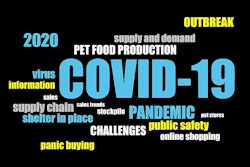
According to Packaged Facts’ “U.S. Pet Market Outlook 2020–2021,” in 2019 e-commerce in the pet space finally did the inevitable and caught up to pet specialty chains in terms of market share (22% of the market each), surpassing discount stores/supercenters (21% market share) on its way to the top.
Such channel growth over the last few years already had the pet industry investing more in e-commerce logistics, and as it turns out that foresight might just contribute to the industry’s past-demonstrated “recession resistance” in the wake of the current COVID-19 pandemic affecting every economy in the world. But what about a newer element of the pet space, one that has grown exponentially over the last few years to the point of becoming saturated with companies and brands looking to get a piece of the pie?
CBD seeing e-commerce growth alongside other pet segments
There is now a well-recorded initial trend of sales spiking in just about every industry in the initial days of COVID-19 taking over the (digital and otherwise) airwaves. The pet industry was no exception, with sales spikes coinciding with shelter-in-place orders in the U.S. In a pattern no one could have foreseen when writing up their 2020 budgets, product sales jumped significantly and then dipped as people stockpiled and then had no need to purchase more product on their normal schedules. Those spikes are expected to continue, and they’re expected to be seen largely in the e-commerce space thanks to people doing their best to avoid their fellow humans in a continuing effort to “flatten the curve” of COVID-19 cases globally.
Cannabidiol (CBD), the pet industry’s latest ingredient trend which is seeing triple-digit growth, also saw those spikes — but the segment is experiencing something more, as well.
“There’s definitely been a lot of spiky mentality,” said Bethany Gomez, managing director of market research and consumer insights firm Brightfield Group, which focuses on the CBD and cannabis industry. “With CBD the amount of product you get has a longer duration than pet food; for example, you may get a bottle and it may last you a couple of months. So we did see a huge spike in e-commerce, particularly when the first shelter-in-place mandates were given.”
Interestingly for a more premium trend, however, is that e-commerce CBD sales (in both the human and pet spaces) have stayed high.
“They spiked up and then have held at about 30% above what typical e-commerce sales are,” said Gomez. “So there’s been some spikes and some cyclical nature — it can be up or down from one day to the next — but on average for brands that have a strong e-commerce presence to begin with they’re seeing their sales up and sustained.”
Shake-up of the CBD space coming
There has been a lot of talk on the economics side of things in all industries that COVID-19 might not actually create any new business trends, but that it will most certainly accelerate trends that are already in motion.
“[The CBD] category was overcrowded coming into this space,” said Gomez. “And what we saw in the CBD category in general is that there were no barriers to entry. Because there was such strong opportunity, thousands of brands were entering the space. At the end of 2019 we were counting more than 3,500 CBD brands operating in the space. While the market has grown exponentially and is very, very strong and much larger than it was a year ago, it can’t sustain 3,500 brands.”
Everyone has been expecting the CBD space in pet to eventually condense, but that shrinking might come sooner than previously thought thanks to the pandemic.
“COVID-19 is definitely expediting that process, by both restricting access to capital for brands to go out and get more as they burn through their reserves and also in [the shifting focus of consumers],” said Gomez. “At the end of 2019 there were 100,000 brick-and-mortar outlets around America carrying CBD products. Well, a lot of those outlets are closed right now and a lot of those small brands are not going to be able to survive. We’re expecting at least half of the brands that were on the market to not be able to survive. That includes the bottom half of the competitive landscape, but also some of the larger ones if they were already burning through a lot of cash and were pushing hard on brick-and-mortar sales.”
And while nothing significant along that vein has happened yet, it’s on the horizon.
“I think that’s something we’re starting to see the beginning of, but what that means is a lot of these little guys, if they don’t pivot very quickly to a strong digital strategy, may not be able to come out the other side of it,” said Gomez. “For those that do come out the other side of it, they’re going to be emerging into a much lighter competitive landscape.”
Briefly: Keep up with the latest pet-related COVID-19 coverage
- View our continuing coverage of the coronavirus/COVID-19 pandemic.
- Take the Petfood Industry COVID-19 survey.
















